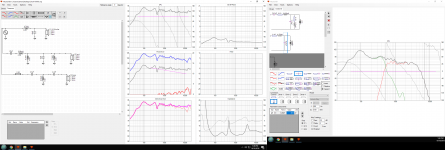I am most concerned about how I have the crossover set up for the midrange, is this an acceptable way of doing it? I did it this way because the impedance kept getting close to 3 ohms.
I know about the dip at 400hz, I want want to get this midrange figured out first.
Thanks
I know about the dip at 400hz, I want want to get this midrange figured out first.
Thanks
Attachments
You have two inductors (8.2 and 1.5 mH) parallel to the midrange, instead of one.
Woofer impedance is questionable - it is rising continually below 100 Hz.
But is it ok to have two of them in parallel?
I feel your pain! A 3 way crossover, with compatible drivers and working with years of experience is a tough task. There are SO many variables.
After 50 years of doing this, my advise is, assuming you must do your own design, is to work hard on driver selection. Base your design on wide band drivers with as flat a frequency responds as is available, low LE, and proven performance. After that, crossover is everything! The simpler the better. The big issue for most first time designers is access to crossover parts. Theoretical is one thing, outcome is very often another. Even with hundreds of parts available to me, it is still a challenge to get a design just right. Not trying to discourage you, it will take a lot of work, trial and time to get to a viable design. By viable, I mean a design that extracts the best possible performance from the drivers, AND you really like to listen to for long periods of time.
After 50 years of doing this, my advise is, assuming you must do your own design, is to work hard on driver selection. Base your design on wide band drivers with as flat a frequency responds as is available, low LE, and proven performance. After that, crossover is everything! The simpler the better. The big issue for most first time designers is access to crossover parts. Theoretical is one thing, outcome is very often another. Even with hundreds of parts available to me, it is still a challenge to get a design just right. Not trying to discourage you, it will take a lot of work, trial and time to get to a viable design. By viable, I mean a design that extracts the best possible performance from the drivers, AND you really like to listen to for long periods of time.
But is it ok to have two of them in parallel?
You may replace them with a single 1.2mH or 1.3mH. Well the DCR will change but your values for your 8.2mH and your 1.5mH may not have been accurate anyway.
1.27 mh with a DCR of .17 ohms. If this is just a sim, you’’ll get the same result. If you have actual hardware that you like the sound of, take turns off the 1.5mh until it measures the same L as the parallel combo did. DCR will go in the right direction. That 8.2 mh low DCR coil would be expensive and unnecessary.
When reduced to the equivalent parallel L, you wind up with one of the two valid topologies for a single terminated band pass with 2nd Order high and low pass slopes. It is just a series resonator followed by a parallel one. It is no better or worse in theory than a 2nd order high pass followed by a low pass. You use whichever plays better with your drivers (which are not just a resistor and have their own roll offs) and/or results in more manageable L and C values.
When reduced to the equivalent parallel L, you wind up with one of the two valid topologies for a single terminated band pass with 2nd Order high and low pass slopes. It is just a series resonator followed by a parallel one. It is no better or worse in theory than a 2nd order high pass followed by a low pass. You use whichever plays better with your drivers (which are not just a resistor and have their own roll offs) and/or results in more manageable L and C values.
Your mid looks far too insensitive to be used with that woofer - in the second example there is almost 10dB difference between the bass and the treble. This will make it sound way too bass heavy unless you are putting them in a very large room or outside.
The dip at 400Hz was because the phase matching between the woofer and mid was poor. You need to turn on individual phase response plotting for each driver and try to get them to match at the crossover frequency (and ideally, >1 octave either side of the XO.
The dip at 400Hz was because the phase matching between the woofer and mid was poor. You need to turn on individual phase response plotting for each driver and try to get them to match at the crossover frequency (and ideally, >1 octave either side of the XO.
Last edited:
- Status
- This old topic is closed. If you want to reopen this topic, contact a moderator using the "Report Post" button.
- Home
- Loudspeakers
- Multi-Way
- Is there a wrong way to design a crossover?
